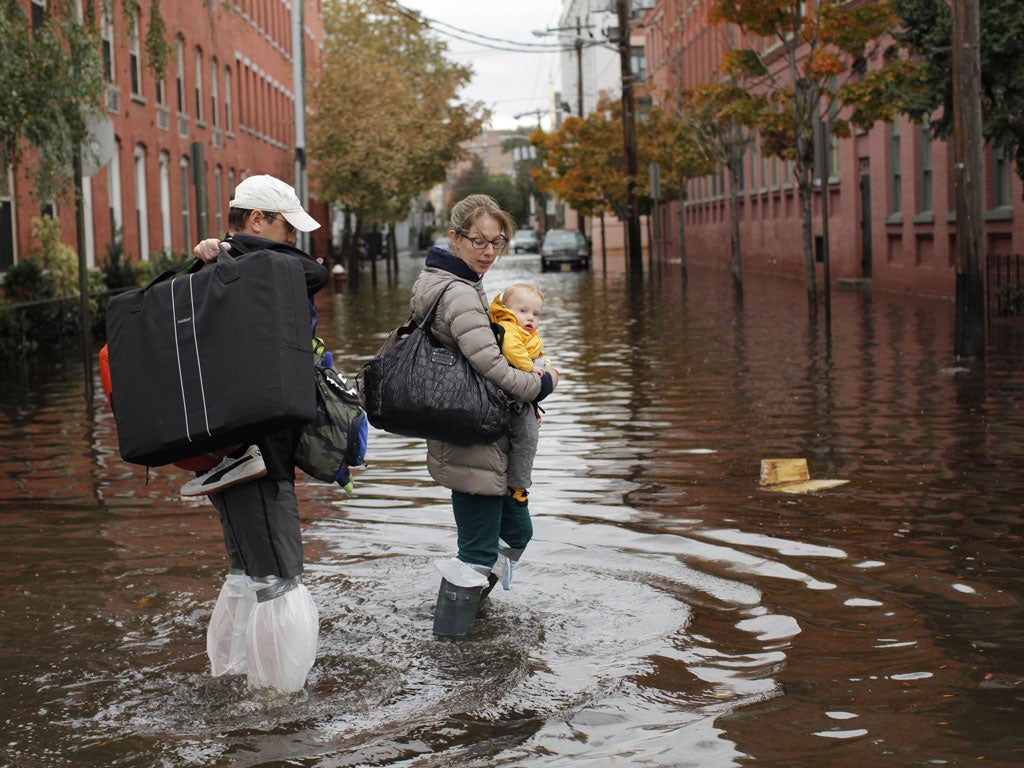New York's neighbours face life after the storm
Manhattan may have been hit hard, but across the Hudson the damage is even worse

"Good afternoon. Can I have your attention, please?" volunteer Tom O'Connor called into a loudspeaker in the lobby of a Bloomfield Street apartment building whose residents were elderly people on low incomes.
Mr O'Connor, an international sales consultant, had come to ensure that the building's water was still available on the higher floors. Many residents were furious at the conditions.
"The elevators are dark," said Frank Bongiorno, 80, who had walked down 13 flights of stairs to the flooded street in search of somewhere to charge his mobile phone. "We've got a lot of people on respirators here. Why are they doing this?"
Two days after the superstorm Sandy struck the East Coast, rescue officials have become accustomed to working in flooded cities and battered beach towns that remain dangerous and chaotic, particularly in pockets of hard-hit New Jersey.
Large parts of this old factory city are still under water and pumps are working flat out to clear a toxic and potentially deadly mix of water, oil and sewage estimated at more than 500 million gallons. National Guard troops in four-wheel-drive trucks patrolled the flooded streets, trying to evacuate the most vulnerable of the city's 20,000 stranded residents, nearly half of Hoboken's population, who were told to stay inside and signal for help with pillowcases.
Dawn Zimmer, the mayor, stood in the gathering darkness on Wednesday afternoon and begged the outside world to send necessities such as torches, batteries, food, generator fuel and drinking water. "We ask anyone who's listening to deliver supplies to us," she said from the steps of City Hall, which was without power.
The mayor spoke over the sound of whirring water pumps and humming diesel generators. The smell of sewage, seeping up from storm drains, hung in the air on some of the city's streets. "If people who are listening have generators, we are asking you to bring them," Ms Zimmer said. "We are still very much in crisis mode."
The number of victims claimed by Sandy in the US had risen to at least 82 by last night – the majority of them in New York. But across the Hudson River in New Jersey, state officials reported at least 14 dead; and here the scope of the damage, which runs from beach communities to ageing cities, appears to dwarf that in New York.
Thousands of Hoboken residents stayed either because they had nowhere to go or because getting out was too difficult. They wandered the streets or drifted toward the handful of working generators to charge their mobile phones and try to renew contact with the outside world. The historic clocks lining Washington Street, the main thoroughfare, all showed the time as 9.03pm – the moment when the city lost power on Monday.
Nonetheless, amid the devastation signs of progress were apparent. Local power company officials, aided by crews from nine states, estimated that they had restored electricity to about 500,000 New Jersey residents. For some, though, the wait for power was expected to be as much as 10 days.
This once-gritty industrial city has become a haven for younger professionals seeking a cheaper alternative to Manhattan. In Hoboken's neighbourhoods, they mix with immigrants and older residents who came to the city decades earlier to work in its factories.
Inside the darkened City Hall, built in the 19th century, a volunteer operation took shape, with young people lining up to pick up torches and addresses where older residents might need help.
"Can I have the Spanish-speaking people raise their hands," a volunteer co-ordinator shouted. "It is very hectic right now."
National Guard trucks have ferried evacuees to City Hall. From there, those who were able to walked to Jersey City to find friends or relatives who could take them to a safer, drier place. Others were taken to shelters.
But for many of the vulnerable, volunteers like Mr O'Connor were the first contact. Wilbert Rivera, who has survived on disability benefits for four years, sat on the kerb near City Hall.
The 46-year-old native Puerto Rican rolled up his right trouser leg to show a swollen knee and complained that he was in pain. He had finally been rescued by the National Guard from his flooded block late on Wednesday afternoon.
"Gout," he said, pointing to his throbbing leg. "Waiting to hospital, please."
Subscribe to Independent Premium to bookmark this article
Want to bookmark your favourite articles and stories to read or reference later? Start your Independent Premium subscription today.

Join our commenting forum
Join thought-provoking conversations, follow other Independent readers and see their replies